Matador Network's Blog, page 856
May 18, 2020
Best things to do in Las Cruces, NM

Most travelers to New Mexico set their sights on Santa Fe, Taos, or Albuquerque, destinations that each merit a visit. But the state’s less-traveled southern region has a fascinating vibe and culture all its own. Las Cruces is a friendly city along the Rio Grande just north of Mexico, next to russet-hued mountains that offer excellent opportunities for hiking and exploration. Add in savory cuisine spiced with green chilis and washed down with local wines, a fascinating history, and some unexpected cultural offerings, and Las Cruces is worth getting to know better. Here’s how to visit.
Take a detour to a quirky town

Photo: SunflowerMomma/Shutterstock
You can fly into Albuquerque and hop on I-25 South for the three-hour drive to Las Cruces. An hour before you reach Las Cruces, turn off the I-25 to swing through Truth or Consequences, a tiny town just west of Rock Canyon and Elephant Butte State Park. Originally named Hot Springs for its abundant geothermal springs, the town voted to change its name after the popular NBC radio show Truth or Consequences promised publicity and aired a promotional broadcast here in 1950. Today the town’s roughly 6,000 locals affectionately call their home “T or C” and still welcome visitors who come for the thermal springs and their therapeutic qualities.
Peruse local crafts and produce
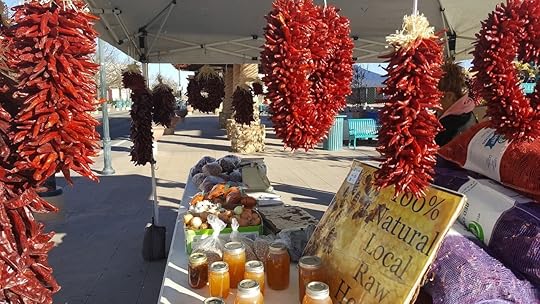
Photo: Farmers & Crafts Market of Las Cruces/Facebook
If you’re in Las Cruces on a Wednesday or Saturday morning, visit the Farmers & Crafts Market of Las Cruces, which has been a tradition here for nearly 50 years. Craft and food vendors set up on the Plaza de Las Cruces for the smaller Wednesday market. And on Saturday, seven blocks of Main Street shut down for more than 300 vendors. Handmade, locally crafted goods include jewelry, tooled leather, ceramics, clothing, and furniture. Farmers sell their produce, green chili, local honey, and desert plants. You can sample baked goods and homemade kombucha for breakfast or fill up on New Mexican specialties around noon. Live music adds to the festive atmosphere.
Hike in the ochre hills

Photo: Richter MachThunder/Shutterstock
Hiking here is accessible year-round. In the Organ Mountains 10 miles east of Las Cruces, Dripping Springs Natural Area offers four trails. From the visitor center, the moderate 1.5-mile Dripping Springs Trail climbs to the ruins of the 1870s Dripping Springs Resort that hosted famous guests, such as Pancho Villa, and boasted a concert hall in the wilderness. Along the trail in different parts of the canyon, you can also explore remnants of a livery and sanatorium.
Nearby, the easy Soledad Canyon loop takes you to a waterfall that flows in the spring rainy season, dries to a trickle in the summer, and often forms a frozen cascade in winter. Located three miles east of New Mexico State University, two trails circle Tortugas “A” Mountain, and one leads to the top with 360-degree views.
Savor cuisine spiced with local chilis

Photo: Elizabeth Hey
If you’re looking to sample New Mexican cuisine, you can eat your way through local hangouts for at least a month. On the colorful patio at Andele’s Dog House, where dogs do get special treatment, specialties include tacos al carbon with salsa bar toppings ranging from mild to smokin’ hot. Cozy, family-owned La Nueva Casita Café lies within the Historic Mesquite District, the original town site of modern-day Las Cruces. Serving up solid Mexican fare and a kitschy vibe, La Posta de Mesilla resides within an iconic 18th-century stagecoach station that features a piranha tank and aviary.
For a drink, grab a margarita at the Imperial Room at Double Eagle, which also serves up New Mexican steaks under a hammered-gold ceiling in a restored, and some say haunted, 1849 mansion. At DH Lescombes Winery & Bistro you can sample locally produced wines, which pair well with the comfort-food menu. In a region famous for its Hatch Valley chilies, a tour of its restaurants may well end up at the walk-up window at Caliche’s Frozen Custard for its sweet-spicy green chili sundae.
Take in the historic art
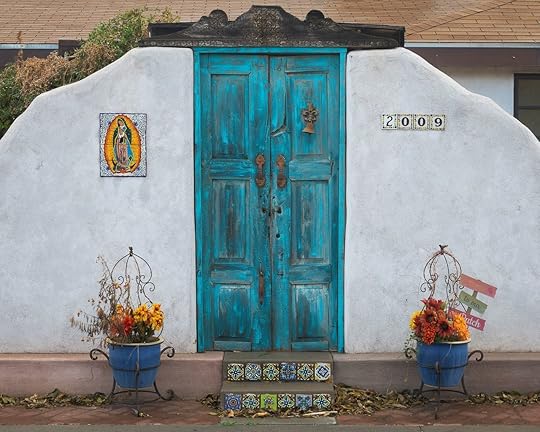
Photo: Nagel Photography/Shutterstock
Central to New Mexico’s history, the historic town of Mesilla lies 10 minutes from downtown Las Cruces. In 1850, shortly after the end of the Mexican-American war, Mexican citizens settled into what they called La Mesilla on the Mexican side of the border. Just a few years later, that border moved 40 miles south. In the 1854 Gadsden Purchase — referred to as Venta de La Mesilla or “the Sale of the Mesilla” — the US paid Mexico $10 million for 29,670 square miles that are now part of present-day Arizona and New Mexico. The town’s traditional Mexican plaza is surrounded by historic buildings that house shops and galleries, and the bells of the 1855 Basilica of San Albino have been rung by the same family since the 1870s. The Taylor-Mesilla Historic Property shows traditional and adobe architectural styles and Spanish colonial, Mexican, and New Mexican art.
Beyond the art in Mesilla, you can view more at New Mexico State University. The school’s contemporary gallery houses one of the world’s largest collections of Mexican retablos, which are colorful oil paintings on tin. At NMSU’s alumni and visitors center, the curated Zuhl Geological Collection displays petrified wood, minerals, fossils, and geological artifacts. For classic films, theater, or live music, downtown’s Rio Grande Theatre, built in 1926 and on the National Historic Register, is the nation’s only remaining two-story adobe theater. And on first Fridays, you can pop into galleries between Main and Mesquite during the “Downtown Ramble.”
Marvel at bright white dunes

Photo: sunsinger/Shutterstock
White Sands National Monument, the nation’s newest national park, lies about 45 miles east of Las Cruces. At 275 square miles, the world’s largest gypsum dune field can be seen from space. At the visitor center, rent a saucer to slide down the dunes or, better yet, bring your own. It’s also a great place to bring your dog.
Winding eight-mile Dunes Drive leads you through this whitewashed panorama, and numerous turnouts invite exploration. Near the apex of the drive, the five-mile Alkali Flat Trail is well worth the two or three hours, depending on your stamina, as you hike up and down the massive dunes with red markers to keep you oriented.
Gypsum doesn’t absorb heat from the sun, which makes the sand cool and comfortable to walk on, even in summer — but be sure to take plenty of water as there’s no water available beyond the visitor center. Just note that because White Sands Missile Range surrounds the dunes, the monument closes during missile testing. Closures can average twice weekly for one or two hours.
Munch on pistachios

Photo: Kristi Blokhin/Shutterstock
Only a few places in the world have the conditions to grow pistachios, and Alamogordo is on that short list. After a visit to White Sands, head about 30 minutes further east to Eagle Ranch and check out one of the healthiest nuts on the planet. The store offers complimentary samples of its pistachio chocolates and wine from the acreage’s seven grape varieties. Free tours offer a glimpse of the growing, harvesting, and roasting process. Overlooking the pistachio grove, cozy patio sofas invite you to sip a glass of wine or enjoy creamy pistachio ice cream before heading back to Las Cruces. 
More like this Trip Planning How to spend 48 hours in Taos, New Mexico
The post Red mountains, blue skies, and green chiles in Las Cruces, New Mexico appeared first on Matador Network.

Seoul digital wave how does it work

Billboard ads have become a ubiquitous part of our cities and highways, but rarely do they show anything worth looking up for. In Seoul, the largest advertising screen in South Korea isn’t exactly a canvas for cheesy accident lawyer ads. D’strict, a digital media tech company, is using the screen to display a massive computer-simulated ocean wave, as part of the Public Media Series.
The billboard is located in Seoul’s COEX Square — the location of a convention and exhibition center that also serves as a giant mall. The wave itself is designed to look like a rough ocean storm trying to break out of the screen containing it. It utilizes anamorphic illusion methods to create the effect, as well as a collection of smart LED displays that work together to form a single unified image. The display also has audio, making the illusion of a massive urban wave even more immersive.
The screen itself is 262 feet long and 65 feet high, with a whopping 17,430 square feet of screen space, often drawing comparisons to New York City’s Times Square, which is similarly known for its huge, flashing billboards.
D’strict is also responsible for several similar projects, including an interactive visual experience at Cafe.Bot and a 3D installation at the Lotte World Magic Circle. 
More like this Culture Ski the Powder Highway in British Columbia, Canada
The post This massive digital wave in Seoul is a mind-blowing, immersive illusion appeared first on Matador Network.

Qatar Airways flight attendants PPE

Your flight attendant is about to look like they just stepped off the set of Breaking Bad.
They will, at least, if the rest of the airline industry takes its cue from Qatar Airways, which today released images of its new in-flight cabin crew uniforms. Which don’t look at all unlike the uniforms they wore in the basement of Lavanderia Brillante.
The stunning, all-white PPE suits will be worn by every member of the cabin crew — including the first-class bartenders. In addition to the suits, the crew will be donning protective goggles, sanitary gloves, and a face mask. The suits are fully disposable, as well, so the crew won’t be spreading any germs from one flight to the next.
Those flight crews will be broken up into two groups — one manning the outbound flight and one for the inbound flight. This, again, ensures a minimal transference of germs and allows for quarantines should anyone onboard exhibit symptoms.
Passengers will also have to wear masks beginning May 25. The PPE suit, should a passenger own their own, is purely optional.

Photo: Qatar Airways
In addition to the new in-flight uniforms, Qatar Airways will be serving all business class meals in trays with disposable utensil wraps to minimize contact points. The cuisine will continue to be elevated from what’s available in the main cabin, but will be served in much the same way. You’ll also find ample hand sanitizer at almost every location on the plane.
At Qatar’s home airport in Doha, you’ll also find autonomous robots roving the concourse, emitting a UV-C light that’s been shown to kill infectious viruses.
“Seeing as we are still flying the world’s largest international network by operating flights to more than 30 destinations around the world, and aiming to grow our network again in the coming months, these onboard safety measures will assist us in achieving our goals,” Qatar Airways Group Chief Executive, His Excellency Mr. Akbar Al Baker, said via a press release.
Though Qatar’s PPE suits are among the first to appear on a major airline, they may well not be the last. And as we begin to take to the skies again this summer, your laptop-stowing admonitions may well be coming from someone who looks slightly more menacing than your average flight attendant. But strange as it may look, remember, it’s all for your protection. 
More like this Highlights of a week in Quebec
The post Qatar Airways flight attendants will wear full PPE gear appeared first on Matador Network.

Copenhagen attractions kindergartens

Scandinavian countries are known for developing creative and effective solutions to societal problems at large. So it’s no surprise that Copenhagen, Denmark, has developed a definitively Scandinavian solution to providing childcare for some overwhelmed parents during the COVID-19 pandemic: The city is turning many of its most popular public attractions into temporary kindergartens.
The beautiful Tivoli Gardens amusement park and FC Copenhagen football stadium, along with the Copenhagen Zoo and the National Museum of Denmark, have opened their doors to children between the ages of three and six. The kids get to hang out and experience the cultural attractions, learning and lunch included.
Though schools in Copenhagen have reopened following the worst of the pandemic, the city deemed additional measures necessary after it was determined that social distancing requirements would prevent schools from being able to accommodate all of their students. Fortunately, those in charge of the public spaces rose to the challenge.
“We are almost ready with all our institutions, but it is with limited capacity,” said Jesper Christensen, Mayor of Copenhagen’s Children and Youth Administration, in a public statement about the decision. “That is why we need to be creative and here I am pleased to find that our large cultural companies, housing associations and sports institutions are willing to step in.”
Social distancing measures will be followed at each of the temporary facilities, with each child receiving 12 square feet of space. All activities throughout the day happen outside whenever possible, and the areas are being strictly maintained for cleanliness and sanitation. “Our teachers and educators right now are making a huge effort to send our children back safely and safely, and here we can help them a bit,” said Katja Moesgaard, the COO of the FC Copenhagen football club, in the public statement. “We have a responsibility for educating the Copenhageners.” 
More like this Budget Travel The best free (and almost free) things to do in Copenhagen
The post Copenhagen transformed its iconic attractions into kindergartens appeared first on Matador Network.

Best tips for camping with kids

This looks to be the year the world goes camping. But the Great Camping Return of 2020 may seem like a challenge for families who haven’t introduced their kids to this quintessentially American pastime. We’ve got you covered on how to pitch a tent and what to bring, and here we focus on what will make your family camping trip unforgettable — and only in a good way.
We asked kids what they love best about spending the night outdoors and then added in some hard-earned parental wisdom. These resulting tips will ensure a successful camping trip with the little ones — and hopefully start some new family traditions.
Bodies of water
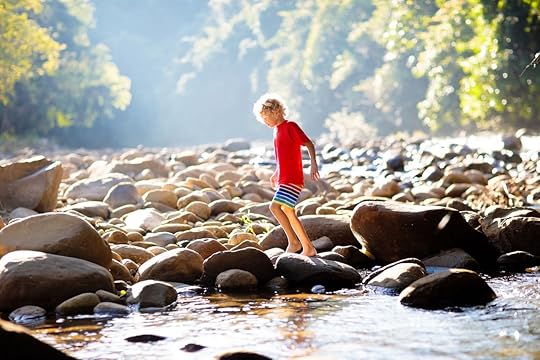
Photo: FamVeld/Shutterstock
Kids love water, especially if they can safely swim or wade in it. So try to include water into your outdoor getaway. Rather than hiking uphill toward a stunning view, which may not impress your kids as much as it does you, hike toward an alpine lake instead. No matter how icy, jumping in that lake will be a welcome reward for the hike. Even a trek to a shallow creek that kids can splash around in will be an excursion that kids can get excited about.
Fire
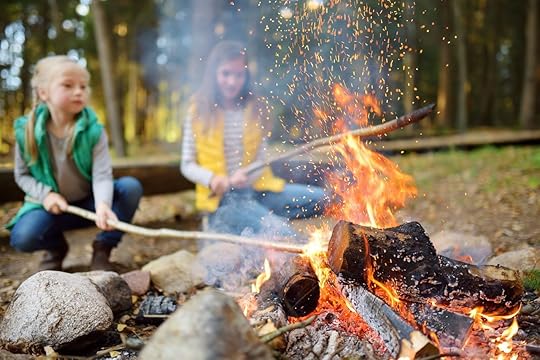
Photo: MNStudio/Shutterstock
Fire seems to have a magical pull on young ones, and camping is one of the few times they can interact with fire in a controlled way. One reason kids love s’mores so much is that they’re not only dang tasty but also made in fire. So if there are any other food items that kids can make in fire, let them. Maybe they can cook sausages on a stick over the fire — a popular thing to do in the Nordic countries — or a metal grill so they can make pancakes over the fire. Yes, a camp stove is more convenient, and you should have one, but use that fire where (safely) possible.
Freedom
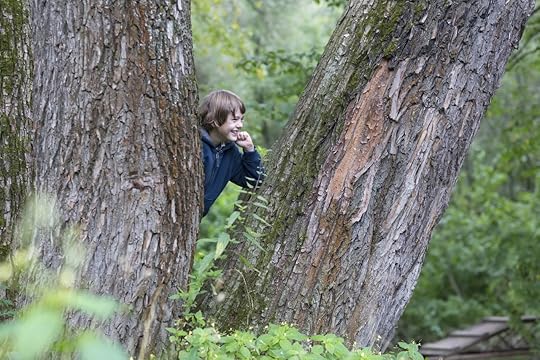
Photo: FamVeld/Shutterstock
Quite possibly the most exciting thing about the great outdoors is the freedom to explore, a feature of childhood that kids still read about in books and see in movies — but are rarely allowed to do near their homes. Exploring the area near a campground, especially in something like a game of hide and seek, is thrilling for kids. Just be sure to lay down specific guidelines about how far they can wander before they set out.
Independence
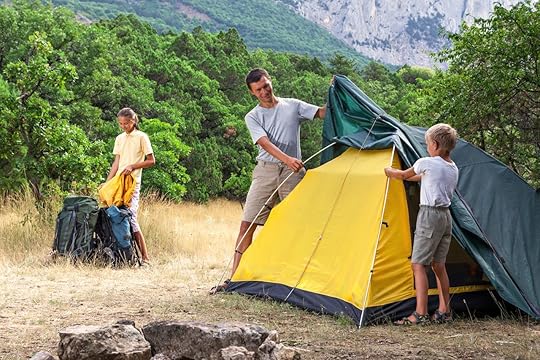
Photo: Stas Tolstnev/Shutterstock
A corollary to freedom is the independence to make their own choices. Let kids pack for the camping trip, drawing from a list of essentials that you’ve given them — just be sure to check what they’ve packed before you head out. Also, ask them what foods they’ll want to eat on the trip. And when you arrive, let the kids personalize their tent. Beyond getting their input on where the tent should be, and helping them set it up, let them “decorate” the tent with a hanging lantern inside and maybe even a string of lights outside.
Creating

Photo: Bilanol/Shutterstock
There’s a reason we fill our cupboards with crayons and wonder what to do with the endless artworks kids bring home from school. Children are happiest when their imaginations are inspired and they’re using their hands. So bring one toy if you have to, but trust the outdoors to be the source of entertainment instead. Make it a no-electronics weekend and help the kids make forts out of sticks, “bake” mud pies (with your supervision if they’re near water), and create artworks in the dirt on the rocks using the natural materials they find around them.
Not keeping time

Photo: Dollydoll29/Shutterstock
Kids’ lives are often ruled by time. Every day is a race against the clock — setting off to school, getting to class, waiting for recess, pining for the day to end, and then heading out to one or more after-school activities. Even weekend sporting commitments mean time is ever-present in their lives. So do them a favor: In addition to taking away their electronics for the weekend, hold onto their watches for a while. While you may need to know the time, the kids should enjoy a day or two with only the sunshine and mealtimes as their chronological guide.
Sleep

Photo: Collin Quinn Lomax/Shutterstock
Okay, on camping trips kids may not actually want to go to sleep given the pull of the campfire, ghost stories, and the rest. But while kids may not want it, they do need it. And so do you. So don’t skimp on this part. If you’re car camping, an inflatable air mattress is worth the expense and space in your car.
Kids love small spaces. There’s just something comforting about it for them. That’s one reason they seem to love tents so much — because you’ve just taken a house or bedroom and shrunk it down to its most essential part. You can also make them feel cozy by the fire, with comfy blankets they can wrap themselves up with. (Just don’t use these later for sleeping since they’ll be full of dirt and smell like smoke.)
Campfire songs
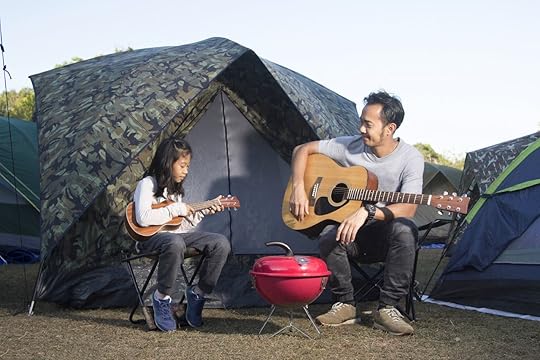
Photo: My Life Graphic/Shutterstock
We don’t need to tell you how much kids love them. If you can play even a few chords on a guitar, banjo, or ukulele, bring that instrument along. And don’t worry if you’re not a musical family or don’t know any fireside ditties. If your kids have been to any summer camps themselves, they’ll know more than enough songs for a night. Let them sing while you mumble along. And should “Kumbaya” not float your boat, James Taylor songs like “Carolina in My Mind” are campfire classics. Kids also tell us that Beatles songs sound plenty comforting and old-timey for a campfire, too.
Also, even though summer’s late sunset can make it easy to put off dinner, just remember the sun will also rise early. And when that light comes in through the trees or over the hill is when your kids will wake up. So start dinner early and eat while it’s light out if need be. Save the darkness for those campfire songs.
Stars
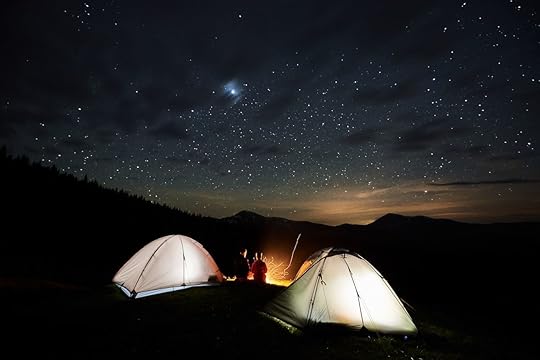
Photo: anatoliy_gleb/Shutterstock
In the same way that kids enjoy reimagining the clouds above as something else, they also love to stare in awe at the night sky. It’s also an activity that rarely fits into their busy weekday schedules and which may not even be possible in cities choked with light pollution. So make sure there’s time after dinner to look up. If you don’t know the names of the constellations, just put your heads together and invent some new ones.
Treats

Photo: Air Images/Shutterstock
Treats, like s’mores, signify that the moment is special. Another treat could be to start the day with hot chocolate. While you savor your camp-stove coffee, let the kids warm up their own hands over some gooey instant cocoa. You can also create other camping-specific “treats.” For example, tortillas are easy to bring since they take up less space than bread, don’t get squished, and are great receptacles for those last-morning, everything-that’s-left fry-ups. So make peanut butter and jelly tortilla roll-ups and tell your kids they’re unique camping delicacies. Since things taste so much better when we’re outside being active, it’ll probably work.
Traditions
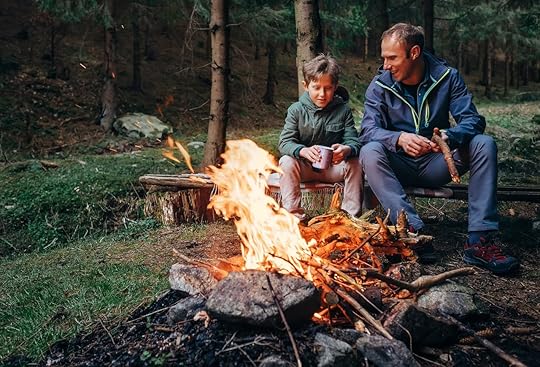
Photo: Soloviova Liudmyla/Shutterstock
Looking at stars and naming your own constellations, singing corny campfire songs, and having messy hot chocolate for breakfast are all part of building traditions. And kids really do love traditions. So take the best ones from your first camping trip together and include them in the next one. Pretty soon the issue you will have is not if your kids want to go sleep outdoors but when they’ll stop begging you to take them camping again. 
More like this Camping The ultimate guide to everywhere you can camp permit-free on US public lands
The post Camping with the kids is easy when you know what they love about it appeared first on Matador Network.

Classic British dessert
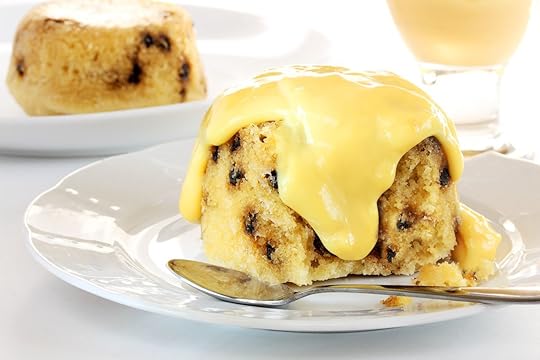
The English are famous for their desserts. There are numerous options, from small cakes served with tea, to towering glasses of whipped cream and fruit, to traditional recipes with a history nearly as long as modern Britain itself. Most of the country’s famous desserts from the past depend on sweetened bread and butter along with cream. Alcohol often plays a major role, as well, whether for soaking, as a main base ingredient, or for starting a fire at the serving table. These are the 11 traditional, classic, and famous English desserts and how they came to be.
1. Syllabub
The syllabub is not the most common nor popular dessert in England today, but it was once ubiquitous. It’s made by adding alcohol to thick cream, causing it to curdle, and then sweetening the mixture and whipping it. The name comes from Sillery wines from France, which were the original alcohol of choice for the dessert. The intoxicating side of the syllabub varied over time, but the name stuck, as Felicity Cloake writes in The Guardian. A mid-1600s version uses cider, which is weaker than wine, while another uses port, which turns the mixture an off-putting purplish color.
Syllabub has yet to experience a revival, but it’s worth keeping in mind and giving it a try when presented with the chance.
2. Fruitcake
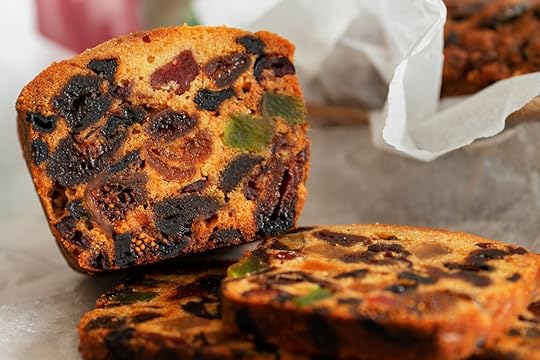
Photo: O.PASH/Shutterstock
Fruitcake is among the most maligned desserts, as seen by the many disparaging remarks made around Christmastime every year. But it’s proven to be one of the most adaptable foods over the past couple of centuries. The ancient Romans made a version of fruitcake with pomegranate, pine nuts, and raisins in a barley mash. Europeans in the Middle Ages added honey, spices, and fruit. It was regularly eaten for sustenance, kind of like a very early version of today’s hiking bars loaded with chocolate chips and dried fruit.
Fruitcake’s connection to England started in the 1400s with fruit from the Mediterranean, according to What’s Cooking America. In the 1700s, people made nut-filled fruitcakes during harvest and didn’t eat them until the next year as a symbol of good luck for the following harvest.
The Victorian era from the mid-1800s to 1900 brought fruitcake to the spotlight. It’s said that Queen Victoria herself waited a full year before digging into a fruitcake because doing so showed “restraint, moderation, and good taste.”
In part due to this long history, variations exist around the world. Italy has panforte, Germany has stollen, and parts of the Caribbean have rum-soaked black cake.
Today, fruitcake remains popular despite the jokes at its expense. Modern versions contain citrus, currants, raisins, spice, and come in a variety of booze-soaked options, including Cognac, Scotch whisky, and rum.
3. Treacle tart
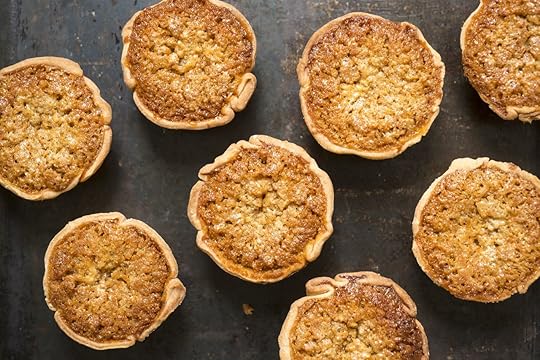
Photo: photographyfirm/Shutterstock
Treacle is a syrup that’s a byproduct of refining sugar, kind of like molasses. This breadcrumb pastry with an open-top middle traditionally relied on treacle for its sweetness, though a synthetic canned golden syrup is often used in modern versions. Treacle tarts are believed to come from the north of England, and one of the oldest recipes (which, naturally, used true treacle) was published in the Newcastle Courant in 1887, according to the Foods of England.
4. Knickerbocker glory

Photo: Matthew Bechelli/Shutterstock
The Knickerbocker Glory is an ice cream sundae that comes in a tall glass filled with layers of ice cream, nuts, fruit, sweet bread, chocolate, and whipped cream. A bright red cherry on top completes the dessert.
There’s a good chance the classic knickerbocker glory wasn’t invented in England. The word knickerbocker was popularized as a nickname for New Yorkers of Dutch descent by Washington Irving’s 1809 book A History of New York from the Beginning of the World to the End of the Dutch Dynasty. It was published under the pseudonym Diedrich Knickerbocker. That surname is also the term for the style of trousers that are tight around the calf and have a wide cut around the waist and thighs.
No one knows when Knickerbocker was first tacked onto the name knickerbocker glory, but Foods of England notes the name of the sundae was in print as early as 1929. Perhaps the dessert’s most recent claim to fame is a mention in Harry Potter and the Sorcerer’s Stone.
5. Bread and butter pudding
h
Photo: Jamie Rogers/Shutterstock
This simple dessert of layers of buttered bread, raisins, spices, and egg custard was one of Princess Diana’s favorites. The earliest recipes date back to the 1700s as a way to repurpose day-old bread, though its low cost (yet big flavor) made it a working-class favorite as well. Fancier versions may add lemon and a splash of alcohol like brandy. For Princess Diana’s version, former Royal Chef Darren McGrady laid out the specific ingredients: raisins, amaretto, white bread (no crusts), butter, egg, vanilla, sugar, milk, heavy cream, and almonds.
6. Banoffee pie
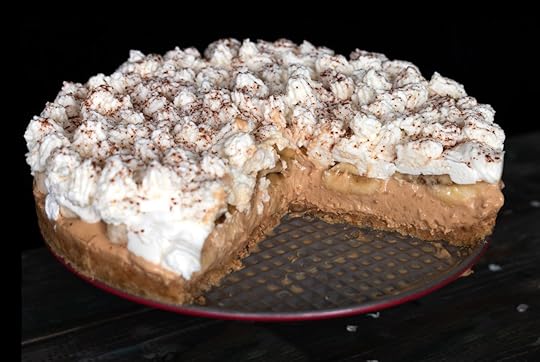
Photo: Yakimenka Volha/Shutterstock
Banoffee pie is made with bananas and toffee, which helped inspire the name, along with a flavorful short-crust pastry and freshly whipped cream. It’s one of the rare foods with a clear origin story. The dessert was created in 1972 by the late British restaurateur Nigel Mackenzie and first served at his restaurant The Hungry Monk in Jevington, East Sussex. Inspiration came from the head chef Ian Dowding, who was a fan of Blum’s coffee toffee pie, which is made with condensed milk and cream.
Banoffee was an instant hit that was imitated elsewhere. It reached complete market saturation when Nestlé printed a recipe on the label of condensed milk cans. No imitations can compare to a banoffee pie made the traditional way, with freshly whipped cream and short-crust pastry, however.
7. Sticky toffee pudding

Photo: gbellphotos/Shutterstock
This steamed sweet dessert is made with sponge cake, dates, and a toffee sauce made with butter, cream, and sugar. Ice cream or custard are two optional, but not uncommon, toppings. By some accounts, it was created by Canadian Air Force officers who passed the recipe to a hotel owner in Lancashire while stationed there during World War II. There’s no denying that sticky toffee pudding as we know it today, however, comes from the Lake District of northwest England. Francis Coulson at the hotel Sharrow Bay was probably the first person to prepare the dish, and today it’s a widespread, and widely loved, treat.
8. Eton mess

Photo: Danilova Janna/Shutterstock
When it comes to English desserts with upper-crust names, Eton mess is the cherry on top. It gets its name from Eton College, the Windsor boarding school for the British elite like David Cameron, Princes William and Harry, and the James Bond author Ian Flemming. In terms of dessert, Eton refers to meringue and whipped cream mixed with strawberries.
According to a cheeky legend, it was created in the 1920s during a cricket match. The chef brought out a prim and proper cake, which was promptly knocked over by a dog. The boys of Eton ate the mess — dog hair and all — regardless. Though a widespread story, it’s not true, and exactly where the Eton mess comes from isn’t clear. What is known is that it’s been around at least since the late 1800s. Arthur Henry Beavan wrote about a menu that included an “Eton Mess aux Fraises” (with strawberries) in his 1896 book Marlborough House and Its Occupants: Present and Past.
9. English trifle

Photo: Irina Meliukh/Shutterstock
A “trifle” means something irrelevant, but the English trifle is always relevant in the world of the UK’s desserts. It’s made with sponge cake that’s soaked in sherry or brandy, fruit, egg custard, and whipped cream. It’s similar to a syllabub, and the two dishes have a shared history, according to The New York Times. English trifles date back to at least 1598, and the recipe was originally made with cream and rosewater before turning into an alcohol-soaked bread and custard dessert in the 1700s. Today, it’s served in a glass bowl to show off the layers.
10. Figgy pudding
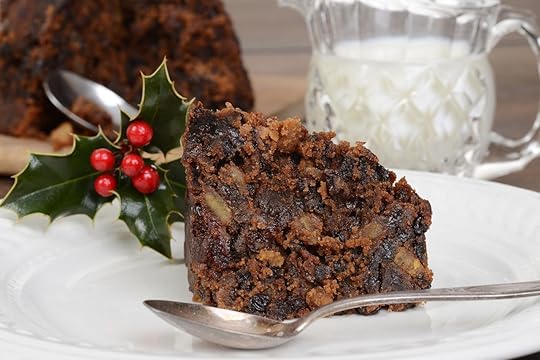
Photo: Michael C. Gray/Shutterstock
Even people who haven’t eaten figgy pudding are susceptible to the earworm of a line from the chorus of “We Wish You a Merry Christmas” — “Oh, bring us some figgy pudding / And bring it right here.”
Figgy pudding is a thick cake made with plenty of bread, butter, sugar, and fruit that’s often topped with toffee and a flambe of rum or brandy. It’s believed to come from 14th-century Britain, though the historic figgy pudding was a much different affair made with meat, dried fruit, wine, spices, and grains. Its association with Christmas started in the 1600s. Figgy pudding’s pop culture credentials don’t end with holiday jingles: It was also included in Charles Dickens’ 1843 book A Christmas Carol. Dickens described the dessert as “like a speckled cannon-ball, so hard and firm, blazing in half of half-a-quartern of ignited brandy.”
11. Spotted dick

Photo: Margoe Edwards/Shutterstock
Spotted dick is a bread pudding made with suet (fat from beef or mutton) instead of butter. The “spotted” in the name refers to dried fruit (traditionally currants). The dessert is believed to have been originally created in the mid-1800s. The “dick” in the name is thought to come from dough, according to the BBC, though it’s been a bit of a sticking point in the modern era — some businesses have opted to call it “spotted Richard” because of all the snickering and jokes. 
More like this Where to Eat
The post 11 creamy, decadent English desserts that will make you wish you were British appeared first on Matador Network.

Italy and Spain will reopen
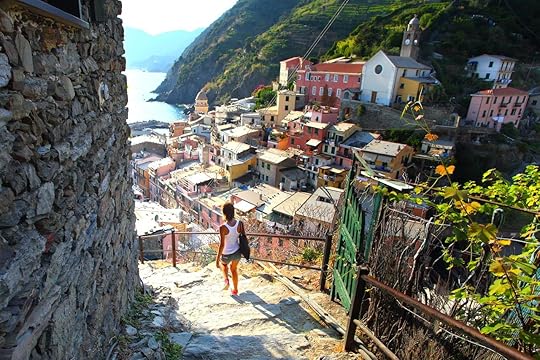
No one really knows when the coronavirus pandemic will end, but countries reopening their borders to tourism is at least a sign of progress. That’s especially true when those countries were among the hardest hit by the virus. Italy, once the epicenter of the virus in Europe, is planning to reopen its borders to citizens of the European Union starting on June 3.
Italy’s prime minister, Giuseppe Conte, acknowledged that the decision was risky, but believes the economic and social devastation of a prolonged lockdown left him with little choice.
“We’re facing a calculated risk in the knowledge that the contagion curve may rise again,” he said. “We have to accept it otherwise we will never be able to start up again.”
Italian factories and parks have been open since May 4, and on May 25, swimming pools, gyms, and sports centers will reopen. With the June 3 announcement, EU holidaymakers will not only be able to enter the country, but they also won’t be required to endure a 14-day quarantine, making the prospect of visiting much more attractive.
And Italy isn’t the only beleaguered nation opening for June tourism. Spain, also heavily affected by COVID-19, is aiming to reopen borders at the end of June, in hopes of reviving its tourism sector that accounts for 12 percent of the country’s economic output.
Transport Minister José Luis Ábalos said in a TV interview, “From late June, we’ll start the tourism activity, I hope…We must make Spain an attractive country from the health point of view.”
Currently, Spain is in the process of easing a strict lockdown, which has been in place since mid-March. 
More like this News All the countries that are slowly opening back up, domestically or for tourists
The post Italy and Spain to start welcoming tourists in June appeared first on Matador Network.

Las Vegas airport vending machines

With hotels and casinos reopening soon with extra safety measures in Las Vegas, the city’s airport is also cleaning up its act.
McCarran International Airport is making it easier for visitors to practice good hygiene by installing new vending machines that sell all the essentials to make their stay in Las Vegas as safe as possible. They dispense hand sanitizer, gloves, wipes, and face masks, making the airport the first in the country to introduce PPE vending machines.
A new option to help protect yourself and others while traveling. LAS was the first airport to install PPE vending machines from which travelers can purchase items like gloves and hand sanitizer. These machines can be found in T1 ticketing and near the T3 TSA checkpoint. pic.twitter.com/1suaVel412
— McCarran Airport (@LASairport) May 14, 2020
Christine Crews, a spokesperson for McCarran International Airport, told the Las Vegas Review-Journal, “It’s not unthinkable that someone will show up at the airport and has left behind one of these items that’s almost essential now to air travel.”
Just don’t expect convenience store prices. It’s an airport, after all. Three packs of disposable masks will set you back $7.50, reusable cloth masks are $14.50, two sizes of hand sanitizer are $4.50 and $6.50, a 10-pack of alcohol wipes is $5.25, and a four-pack of disposable gloves is $4.50. The slightly inflated prices aren’t exactly surprising, given the current high demand for these items.
The machines are located in the Terminal 1 ticketing area and near the TSA checkpoint in Terminal 3. 
More like this Food + Drink The best restaurants and bars at the Las Vegas McCarran Airport
The post Vending machines at the Las Vegas airport are dispensing masks and hand sanitizer appeared first on Matador Network.

May 15, 2020
Inflatable, portable Poimo e-bike

There’s one word that those in the tech-transit bubble are familiarizing themselves with — Poimo. The term, which stands for “portable and inflatable mobility,” refers to a new form of affordable transportation that aims to change how students, professionals, and others living in congested urban areas get around town.

Photo: ACM SIGCHI/Youtube
Currently in the prototype phase, the portable, inflatable e-bike blows up in minutes and fits inside a backpack, meaning that buying one immediately rids you of two of life’s most mundane time wasters — sitting in traffic and searching for a parking spot. You won’t even need to find a bike rack since it folds neatly in your backpack once deflated. It’s quite possible that never before has e-biking been both so nerdy and so epic at the same time.
The inflatable e-bike was developed at the University of Tokyo and is intended to be brought to life with an electric pump in about one minute. Lacking the electric pump, a handheld pump can be substituted, though that slows down the process. After blowing it up, the rider must attach the front and back wheels, an electric motor, a battery, and a wireless controller that doubles as the separate handlebars. It’s designed to fit inside a backpack when not in use, and although the prototype weighs 12 pounds, its creators intend to make it lighter before releasing a finished product to market.

Photo: ACM SIGCHI/Youtube
We’re not quite sure what happens if you were to accidentally puncture the inflated frame of the e-bike, but at least you’d have a moment to dismount before it shriveled to the ground. The frame is made of flexible thermoplastic polyurethane, though, so assuming that it doesn’t puncture easily, the bike is designed with the intention of heavy daily use in urban environments.
Should you buy one you’re bound to be the most unique of commuters in both your social group and workplace. And if you see pedestrians snapping your photo as you whizz by them, it’s certainly not because you’re having a bad hair day. 
More like this Cycling Newly bike-friendly cities want to stay that way post pandemic
The post This new inflatable bike fits inside your backpack for easy storage appeared first on Matador Network.

Lockdown sex buddy

There’s a world of difference between lockdown for single people and lockdown for couples. Singles are sinking into the couch watching Netflix and Tinder-swiping with the vague hope of a FaceTime date. Couples might be sinking into their couches at the same rate as singles, but at least they can have sex afterward. And this disparity is unlikely to change soon. With social distancing in place and bars and clubs off the table, this is perhaps the worst possible time in history for singles have sex.
But fear not, singletons, the Dutch government is all over the issue.
The country’s “intelligent lockdown” allows only three visitors into a household, under the strict condition that those visitors keep their distance. While this rule may be difficult to enforce, it effectively puts the kibosh on hookups. Now, however, the Dutch National Institute for Public Health and the Environment (RIVM) is suggesting that single men and women line up a seksbuddy (sex buddy) to stay sane during lockdown.
“It makes sense that as a single [person] you also want to have physical contact,” they said. “Discuss how best to do this together. For example, meet with the same person to have physical or sexual contact (for example, a cuddle buddy or ‘sex buddy’), provided you are free of illness. Make good arrangements with this person about how many other people you both see. The more people you see, the greater the chance of (spreading) the coronavirus.”
So there you have it. If you were on the fence about your new friends-with-benefits, now you have direct encouragement from the Dutch government.
The new guidance comes after people expressed frustration with the restrictive guidelines, which effectively prohibited them from interacting closely with anyone outside their family. 
More like this Wellness Everything you need to know about having sex while social distancing
The post Dutch government recommends single people have a sex buddy during the lockdown appeared first on Matador Network.

Matador Network's Blog
- Matador Network's profile
- 6 followers



